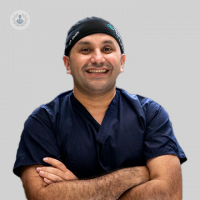Virtual reality for shoulder surgery: what you should know
Autore:Top Doctors recently spoke to revered consultant orthopaedic surgeon, Professor Mohamed Imam, who, in this article here below, outlines the main benefits relating to the use of robotics when performing shoulder surgery.

What are the benefits of using robotics and virtual reality in shoulder surgery?
Shoulder replacement surgery is commonly performed to alleviate pain and restore function in patients with severe shoulder arthritis or other degenerative shoulder conditions. Shoulder replacement involves replacing a damaged or diseased shoulder joint with an artificial implant.
While the surgery has a high success rate, surgeons face several challenges during the procedure, including the implant's accurate placement and proper alignment. These challenges can impact the patient's recovery and overall outcome, leading to prolonged pain and disability.
How does virtual reality technology enhance the accuracy of shoulder surgery?
Augmented reality technology has emerged as a promising solution to these challenges, offering several advantages for surgeons and patients. Using computer-generated images that are projected onto the patient's body, AR technology can help surgeons visualise the shoulder joint in real-time, allowing for greater accuracy and precision during the procedure.
In addition, by reducing the risk of complications, patients may be able to resume their normal activities sooner and with greater ease. This can significantly impact their quality of life, allowing them to return to work, hobbies and other activities previously limited by their condition.
How does the use of robotics in shoulder surgery affect recovery time?
Augmented reality in shoulder surgery can reduce recovery time by minimising tissue damage, reducing the need for prolonged physiotherapy, and improving the accuracy of the surgery. In addition, using virtual reality in shoulder surgery can also reduce the need for prolonged physiotherapy, speeding up recovery. Improving the precision and accuracy can improve the alignment of the implant and reduce the need for physiotherapy, leading to a faster return to normal activities.
Virtual reality technology can also improve preoperative planning accuracy, allowing the surgeon to better understand the patient's anatomy and identify potential issues before the procedure. The added advantage of augmented reality is a real-time understanding of patients' anatomy. This can result in a more efficient and effective surgical plan, reducing the need for intraoperative adjustments.
To book an appointment with Professor Mohamed Imam today, simply head on over to his Top Doctors profile today.


